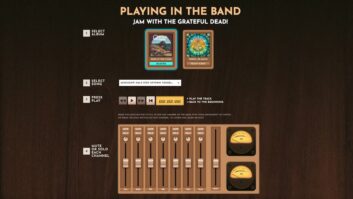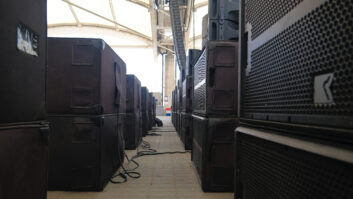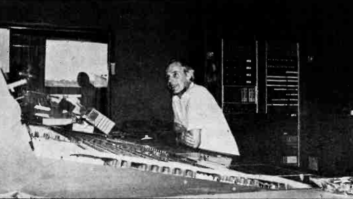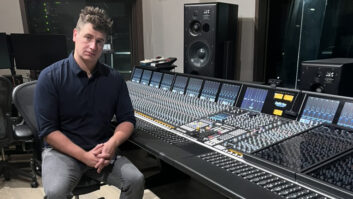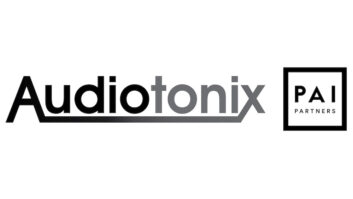Pioneers in the field of techno remixes and monsters of the industrial arena, KMFDM are specialists in the art of transforming sampled sounds from a variety of sources into a thrashing, aggressive dance beat. The band has more than a dozen full-length albums and 20 singles behind them; their most recent set is Adios on the TVT Records label.
KMFDM have been remixing their own and others’ music since 1987. As founding member Sascha Konietzko points out, the band started doing remixes at a time when remixes were rarely done. “In the beginning, I had a day job,” Konietzko says. “I’d scrounge up a little bit of money to go into the studio and just record a track or so, and sometimes at the end of the day that was as good as it was going to get, period. So I figured next time around I’m gonna go back to this, I’m going to do it better. So, essentially, I remixed the song. We remixed and remixed.” Eventually, word got around about the benefits of this approach, and other musicians began asking them to do remixes. And because money for studio time was hard to come by, they had to release everything they did in the studio. Necessity was the impetus for what is now a trend.
Their creative habits have definitely paid off, and these days things are a little easier for Konietzko and Tim Skold, the creative backbone of KMFDM. Beginning shortly after the end of their December 1997 tour, they were able to devote themselves full time to working on new material in each of their private studios.
Konietzko and Skold have identical equipment in their studios, so they can exchange ideas and tracks easily, with no compatibility problems. Konietzko thinks this contributes greatly to the freshness of their sound. “It’s good because you never really run out of ideas,” he says, “you just pass it on and it comes right back with a new breath of life in it.” Their setups include Power Mac 9600s with 350MHz processors, Akai S3000 samplers, Pro Tools 24 rigs, Opcode Studio Vision sequencer/recorders, a variety of synthesizers including Nord2 racks, a Korg Monopoly, several Roland modules (803, 808 and 809), a Pro1 circuit and a total disc array of 70 Gbits. Sometimes Skold uses a Kurzweil 2000, and they use the Akai MPC2000 sequencer for live shows.
“Tim and I started this particular project last December,” Konietzko says, “and it was basically shopping-list style. First of all you just assemble everything that you want this album to be composed of. That means a lot of poking around and sound shaping and sound design, those kinds of things. Then, with all the bits and pieces you already know, you say, ‘Okay, I want to use this loop with that sound.’ You start the assembly phase. At the same time lyrical ideas start to pop up and things start to get arranged in a way so that you know this is probably going to be the verse on the track and this will be the chorus.”
By February ’98, the sound shaping and sound design were done, and Skold and Konietzko began sequencing and mixing. In May they brought the results (along with gear from their studios) into Studio X in Seattle for final mixing and overdubs. These sessions lasted 30 days, allowing approximately three days of mixing per song. Konietzko says the move to the bigger studio was a welcome experience. “The big studio is more or less an emotional type of step in the making of a record,” he says. “You finally get out of the confinement of your little studio, and you can put everything together and hear it in a room that is slightly bigger than what we deal with in our studios. The big studio is important for us because that’s where we have our big console-the SSL with 64 inputs-and enough space to spread out and have more than two people in the room.”
It was in Studio X that fellow KMFDM members En Esch and Gunter Schultz joined Konietzko and Skold. Working with Chicago-based engineer and longtime collaborator Chris Shepard (whose credits include Smashing Pumpkins, Wilco, The Spinnanes and Sonia Dada), the band overdubbed, remixed and polished the pieces. (Guest artists-a norm for KMFDM-were also brought in at this point, including Nina Hagen, Ogre from Skinny Puppy, Bill Rieflin of Ministry and Revolting Cocks, and Cheryl Wilson.)
In terms of the actual process involved at this stage, Konietzko says, “We bring up each song that we have done in our respective studios, and then we just get everything set up on the console, map the entire song, make a document that tells us things like, ‘the next time we bring up this song, the kick drum will be here, etc.’ Once we do that with every song, we go back and figure out if we want to add something to this or if it’s really at the point where we figure this could be mixed. If the answer to that is yes, then we go into mix mode. We take a few hours and lay down a rough idea of a track. And in the meantime, of course, on the way home each night we just listen to these. And after about a total of 10 or 15 days, each song has been up on the console at least twice and has been worked on more or less. Then we go into the final mix mode. That’s when we spend a day or sometimes two-sometimes more-on a song. There are songs that almost mix themselves, and then there are songs that pose a problem and need some overhauling or some reworking.”
One of the most distinctive and unique portions of any KMFDM release is the vocals. Whether contributed by guests or the members themselves, who can mistake the distorted, massively overdriven lyric lines on a KMFDM CD? Shepard describes the method used to obtain this distinctive sound with the simple phrase: “distort and distort again.” Working with a variety of old tube mic preamps, as well as SSL, Focusrite and Neve preamps, Shepard overloads and cranks the outputs beyond recognition. Any pristine quality gained from an overdriven tube is quickly shot through solid-state electronics for clipping. “A lot of the songs we use distortion on aren’t actually sung really hard,” Shepard adds. “We do use mounds and mounds of compression.”
Compressors and limiters play a large role in the band’s signature sound, as Shepard indicates: “Sascha’s Manley compressor played a big part, used as a limiter. We also used a lot of 1176s and several LA-2As. We definitely pounded the mix through an SSL limiter. We like it pumping. Sascha owns several good limiters, and the studio had several good ones, too.”
As far as software is concerned, this is the first full-length project on which KMFDM have used Propellorheads’ Rebirth application. (Rebirth, originally created by Propellorheads Software, is a software synthesizer modeled after classic Roland synths, including two 303-type bass line synthesizers, 808 and 909-type drum machines, plus a multi-input distortion box, delay, compressor, Pattern Controlled Filter and sequencing functions.) Konietzko likes it but emphasizes that it is a complex tool and to be used correctly must be treated as such. “We use Rebirth, but we use it in not so obvious ways. Everybody has it, and a lot of people are obviously able to make fantastic-sounding stuff with it and put out records. We figured that if we used Rebirth, it shouldn’t sound like run-of-the-mill type of stuff.”
KMFDM fans will be pleasantly surprised with the sound of the new record, as the band has again gone in a different direction. In Shepard’s eyes, the difference was the role played by Konietzko. “Sascha is not a guitar player,” Shepard says, “and he had more control at home to record this record. He did more of the soundscaping thing. He found nice tools to work with at home that were aggressive-sounding for him.”
Konietzko agrees that there is a difference in the new album, but he sees it more as a function of his intent: “We consciously omitted as much as possible of the real kind of recording process. Technically speaking, there are little to no guitars on this album. There are hardly any real instruments used at all. Everything is completely synthesized. In the past we used a lot of things like brass sections and guitars. Besides the occasional guitar and one track where there’s a real bass being played, there’s not a single drum hit that is from a real, recorded drum kit.”
Two Pro Tools 24 rigs were used in the studio, one for sequencing and handling all the sound source material and another for recording. They also made limited use of a Studer 827. Shepard likes the Studer because “it creates really good reverse effects; the transport runs in reverse, so it’s handy to do quick little reverse things. Sometimes we do them in the computer, and other times we flip them around in the 827.”
The album was sent to the mastering house on a Pro Tools 24 disk. Shepard points out that the use of the Pro Tools 24 system gave them more control of the final product: “We sent the mastering person a 24-bit mastering file. In the past we would send out just a 16-bit DAT tape. It would come back and we would think, ‘Hmm, it sounds good, or it doesn’t sound so good. Maybe we need to tell the guy to change something.’ This time we were very much involved in the mastering process without physically being there.”
When asked what it is that he does to achieve that signature KMFDM sound, Shepard responds that he isn’t really sure, even after all these times in the studio. “It’s a combination of a lot of things, and it’s a lot of things I don’t know. We work really hard to make it different, but it always comes out KMFDM.”
Alas, Adios is an all-too-appropriate name for the new KMFDM album, for it was recently announced that the group was splitting up. Still, the legacy of 12 years remains, and no doubt we’ll be hearing more innovation from these music/mixing pioneers down the road.

